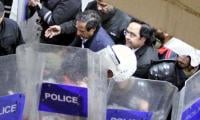Money laundering is a widely used term in Pakistan. To what extent a layperson understands this voguish jargon is a myth. In the hyper-partisan politics of Pakistan, these words are uttered in almost every political debate.
The incumbent government representatives excuse themselves from the dreadful financial conditions of the country, contending the people’s money was laundered to foreign countries by the previous government. The opposition counters with a similar narrative. The vicious cycle goes on.
So what is money laundering, after all? It is the process of turning black money into white, money that is illegally acquired by criminals through criminal activities or misconduct. To use this money for any legitimate purpose, it must first be rendered clean by concealing the illegitimate source(s) from which it was obtained.
Some think the name was coined after the legendary mobster Al-Capone (famously known as the Scarface), who was accused of laundering $1 billion through a network of laundromats and companies. However, the term ‘money laundering’ is thought of having originated in the 1920s during the period of prohibition in the US. John P Robinson, professor emeritus of sociology at the University of Maryland, however, suggests that this term was first used during the crisis of Watergate back in 1973. According to him, the political scandal of Watergate describes money laundering the best, regardless of where this illegal practice has roots. The Watergate scandal showcased how illegal or foul money was put through several transactions which today we call ‘layering’ to make it look legitimate and warranted. In Pakistan, money laundering became an idiolect after the Panama Leaks scandal of 2016 and the subsequent ouster of the then-PM by the Supreme Court in 2017.
Most commonly, once criminals obtain money from criminal activities like the sale and trade of illegal weapons and ammunition, drugs or human trafficking, smuggling or computer and electronic fraud, embezzlement, corruption, theft, bribery, etc, it becomes cardinal to look for means to conceal the source and avoid any attention being drawn by the authorities to the activities and roots of where such profits have been generated from. Moreover, criminals are most likely to move such black money to places where it is less probable that the money shall gain much attention and also try to change the guise of such money.
It is difficult to assume that money laundering only comprises three stages known as placement, layering, and integration as it includes an intricate chain of events and transactions. Nevertheless, it shall be plausible to state that these three stages are the main ones and sufficient to explain the process of the crime of money laundering.
Placement: this is the commencing stage of putting the money or assets obtained from illicit or prohibited activities into the financial system. At this point, the criminal is most likely susceptible to being caught and gaining attention as it is making its entry of prodigious amounts of dirty or black money into the financial system of a country. The purpose of this stage is that the felonious money now becomes a part of the legal financial system and the criminal who is in the possession of such large amounts of cash also gets rid of the responsibility of holding it and being caught red-handed. This may be done internationally or domestically via a variety of businesses including casinos etc.
Layering: also commonly known as structuring, once the money has gone through the stage of placement and has ingressed into the financial system of the country, layering is commenced. This stage further weakens the link of the money to its illegitimate source. It entails the conversion of money or division or transfer to other institutions or overseas markets. Such complex layering of money makes the link from its original foundation extremely weak and puny and further obscures the auditing path. In this stage, money is constantly stirring and not kept in one place, moving between different countries, bank accounts, and/or financial institutions.
Integration: followed by placement and layering, the integration stage is used to reunite the illegitimate money with the criminal. Through this stage, the money seems to casually re-enter the economy via ordinary business dealings or through personal or private transactions. Such integration creates a perception that the money is legally owned by the person and it becomes onerous to distinguish between money that is legitimately owned and money that has been illegitimately sourced.
Money laundering is an international dilemma and requires collective as well as individual efforts at all levels, including widespread public awareness campaigns. Money-laundering laws should constantly evolve due to continuous and persistent changes in modes of conducting this offence – such as use of digital decentralised currency. Money laundering doesn’t only hamper the global and national economy but is used to finance terrorism and carry out all kinds of criminal offences that may disrupt society.
Pakistan needs a robust money laundering regime and understanding of the process. Professional development courses for officials involved – bankers, lawyers, and currency exchangers – along with vigorous due diligence requirements, up-to-date legislation, and strong reporting mechanisms can help curb this curse.
The writer is a lawyer.
The government can directly influence economic activity through current and capital expenditure
A view of the Supreme Court of Pakistan. — Supreme Court website/FileWhat kind of firewall does the judiciary...
Indian soldiers stand alongside a barbed wire on the Line of Control. — AFP/FileAnti-Pakistan propaganda remains a...
A representational image showing farmers harvesting wheat crops in a field. — AFP/FileThere is a clear, lasting, and...
Pakistan's first president Major General Iskander Mirza while speaking with the Turkish Prime Minister Adnan...
Prime Minister Shehbaz Sharif pictured alongside President Asif Ali Zardari. — INP/FileBeing a man of action in...







